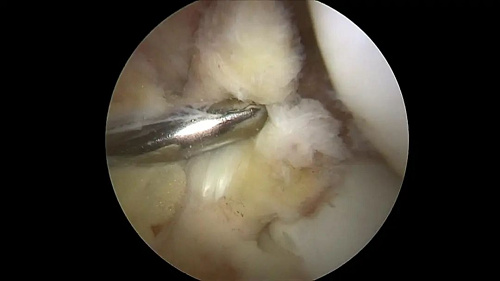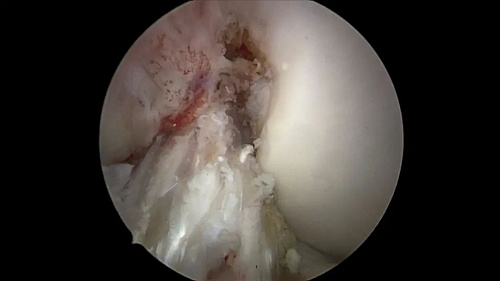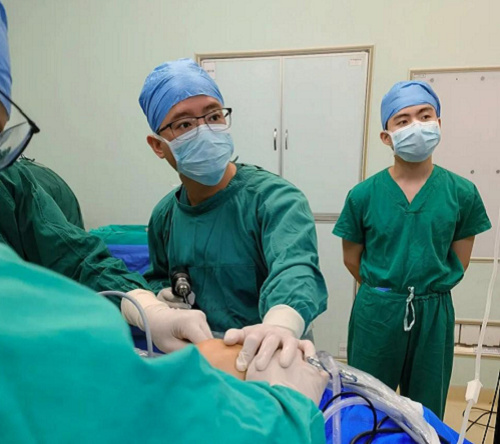UJack, umthandi webhola ekhatywayo oneminyaka engama-22 ubudala, udlala ibhola ekhatywayo nabahlobo bakhe veki nganye, kwaye ibhola ekhatywayo ibe yinxalenye ebalulekileyo yobomi bakhe bemihla ngemihla. Ngempelaveki ephelileyo xa wayedlala ibhola ekhatywayo, uZhang ngempazamo watyibilika wawa, ebuhlungu kangangokuba wayengakwazi ukuma, engakwazi ukuhamba, emva kweentsuku ezimbalwa zokuchacha ekhaya okanye iintlungu, engakwazi ukuma, wathunyelwa kwicandelo lamathambo esibhedlele ngumhlobo, ugqirha wafumana uvavanyo waza waphucula i-MRI yedolo, efunyaniswe njengecala le-anterior cruciate ligament femoral lokwaphuka, isidingo sokulaliswa esibhedlele ukuze kufumaneke unyango lotyando lwe-arthroscopic olungena ngaphakathi.
Emva kokugqiba uvavanyo lwangaphambi kotyando, oogqirha baqulunqa isicwangciso sonyango esichanekileyo semeko kaJack, baza bagqiba ekubeni bakhe kwakhona i-ACL ngendlela ye-arthroscopic encinci esebenzisa i-autologous popliteal tendon emva kokunxibelelana ngokupheleleyo noJack. Ngosuku lwesibini emva kotyando, wakwazi ukuwela phantsi kwaye iimpawu zakhe zentlungu edolweni zakhululeka kakhulu. Emva koqeqesho olucwangcisiweyo, uJack uza kukwazi ukubuyela ebaleni kungekudala.

Ukuqhekeka okupheleleyo kwecala le-femoral le-anterior cruciate ligament kubonakala nge-microscope

I-Anterior cruciate ligament emva kokwakhiwa kwakhona nge-autologous hamstring tendon

Ugqirha utyanda isigulana sakhe utyando lokwakha i-arthroscopic ligament ngendlela engaphantsi kakhulu
I-anterior cruciate ligament (ACL) yenye ye-ligaments ezimbini eziwela embindini wedolo, zidibanisa ithambo lethanga nethambo lethole kwaye zinceda ekuzinziseni idolo. Ukulimala kwe-ACL kwenzeka rhoqo kwimidlalo efuna ukuma ngokukhawuleza okanye utshintsho olukhawulezileyo lwendlela, ukutsiba nokuhla, njengebhola ekhatywayo, ibasketball, irugby kunye nokutyibiliza ezantsi. Iintetho eziqhelekileyo ziquka intlungu ekhawulezileyo, enzima kunye nokuphuma okuvakalayo. Xa kwenzeka ukwenzakala kwe-ACL, abantu abaninzi beva "ukuklikha" edolweni okanye beve ukuqhekeka edolweni. Idolo linokudumba, lizive lingazinzile, kwaye libe nobunzima bokuxhasa ubunzima bakho ngenxa yentlungu.
Kwiminyaka yakutshanje, ukwenzakala kwe-ACL kuye kwaba yinto eqhelekileyo kwezemidlalo, kugxilwe kakhulu ekuzilolongeni okunempilo. Iindlela zokuxilonga le ngozi ziquka: ukuthatha imbali, uhlolo lomzimba, kunye nokuhlolwa kwemifanekiso. I-MRI okwangoku yeyona ndlela ibalulekileyo yokufota ngokwenzakala kwe-ACL kule mihla, kwaye ukuchaneka kovavanyo lwe-MRI kwinqanaba elikhawulezileyo kungaphezulu kwama-95%.
Ukuqhekeka kwe-ACL kuchaphazela ukuzinza kwelungu ledolo, okubangela ukungalingani nokushukuma xa ilungu ligoba, linwebeka kwaye lijikeleza, kwaye emva kwexesha elithile, lidla ngokubangela ukwenzakala kwe-meniscus kunye ne-cartilage. Ngeli xesha, kuya kubakho iintlungu zedolo, umgama omncinci wokuhamba okanye nokuba "ubambeke ngequbuliso", awukwazi ukuhambisa imvakalelo, oko kuthetha ukuba ukwenzakala akukhaphukhaphu, nokuba wenza utyando lokulungisa kunokuba ukulungisa ukulimala kwangoko kunzima, isiphumo sikwabikho kakuhle. Uninzi lotshintsho olubangelwa kukungazinzi kwedolo, njengomonakalo we-meniscus, i-osteophytes, ukuguguleka kwe-cartilage, njl.njl., alunakuguqulwa, okukhokelela kuthotho lweziganeko ezilandelayo, kwaye kwandisa neendleko zonyango. Ke ngoko, ukwakhiwa kwakhona kwe-arthroscopic anterior cruciate ligament kuyacetyiswa kakhulu emva kokwenzakala kwe-ACL, ukubuyisela ukuzinza kwelungu ledolo.
Zithini iimpawu zokulimala kwe-ACL?
Umsebenzi oyintloko we-ACL kukunciphisa ukuhamba kwe-tibia ngaphambili nokugcina uzinzo lwayo lokujikeleza. Emva kokuqhekeka kwe-ACL, i-tibia iya kuhamba phambili ngokungazi, kwaye isigulana sinokuziva singazinzi kwaye sishukuma xa sihamba imihla ngemihla, kwimidlalo okanye kwimisebenzi yokujikeleza, kwaye ngamanye amaxesha sivakalelwa kukuba idolo alikwazi ukusebenzisa amandla alo kwaye libuthathaka.
Ezi mpawu zilandelayo ziqhelekile xa kusenziwa i-ACL:
①Iintlungu zedolo, ezikwilungu, izigulana zinokoyika ukushukuma ngenxa yentlungu enzima, ezinye izigulana zinokuhamba okanye ziqhubeke nokuzilolonga kancinci ngenxa yentlungu engephi.
② ukudumba kwedolo, okubangelwa kukuphuma kwegazi ngaphakathi kwe-articular okubangelwa lilungu ledolo, kudla ngokuvela kwimizuzu ukuya kwiiyure emva kokwenzakala kwedolo.
Ukuthintelwa kokwandiswa kwedolo, ukuqhekeka kwemisipha yemisipha kuguqukele kwi-intercondylar fossa anterior ukuze kuvelise ukurhawuzelelwa. Ezinye izigulana zinokuba nokwandiswa okuncinci okanye ukugoba ngenxa yokwenzakala kwe-meniscus. Xa zidityaniswe nokulimala kwemisipha ye-medial collateral, ngamanye amaxesha kuyabonakala njengokunciphisa ukwandiswa kwemisipha.
Ukungazinzi kwedolo, abanye abaguli baziva intshukumo engafanelekanga kwijoyinti yedolo ngexesha lokwenzakala, baze baqale ukuziva ukungcangcazela kwejoyinti yedolo (oko kukuthi, imvakalelo yokukhubeka phakathi kwamathambo njengoko kuchaziwe ngabaguli) xa bephinda behamba malunga neveki e-1-2 emva kokwenzakala.
⑤ Ukungakwazi ukuhamba kakuhle kwedolo, okubangelwa yi-synovitis ebuhlungu ebangela ukudumba kunye nentlungu kwidolo.
Ugqirha wazisa ukuba ukwakhiwa kwakhona kwe-arthroscopic anterior cruciate ligament kujoliswe ekulungiseni i-anterior cruciate ligament emva kokuqhekeka, kwaye unyango oluqhelekileyo lwangoku kukufakelwa kwe-tendon kwi-knee joint ukuze kwakhiwe i-ligament entsha, eyinkqubo engaphantsi kakhulu. I-tendon etyaliweyo ikhethwa kune-autologous popliteal tendon, enezibonelelo zokusikwa okuncinci, impembelelo encinci ekusebenzeni, ukungalahlwa, kunye nokuphiliswa kwamathambo e-tendon ngokulula. Izigulana ezineenkqubo zokuvuselelwa ezithambileyo emva kotyando zihamba ngee-crutches ngoJanuwari, ziphume kwii-crutches ngoFebruwari, zihamba ngenkxaso esusiweyo ngoMatshi, zibuyele kwimidlalo eqhelekileyo kwiinyanga ezintandathu, kwaye zibuyele kwinqanaba lazo lemidlalo ngaphambi kokwenzakala kunyaka omnye.
Ixesha leposi: Meyi-14-2024










